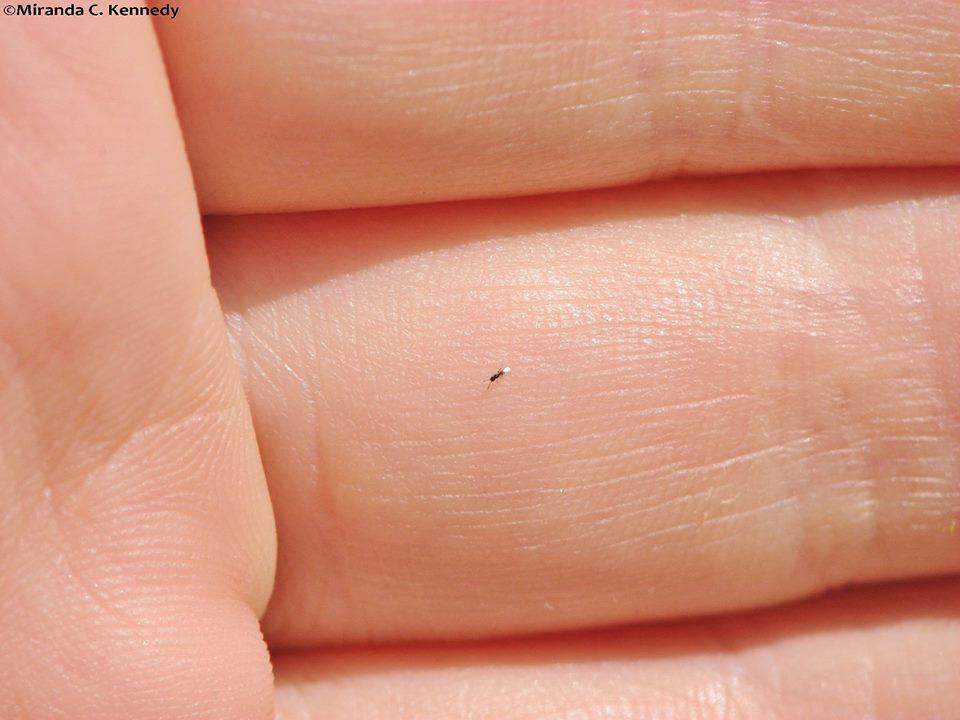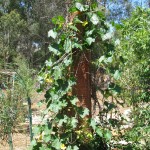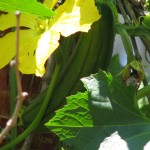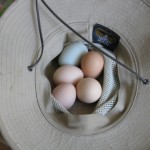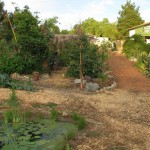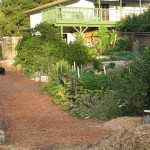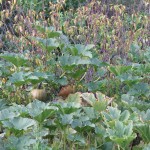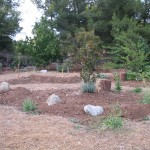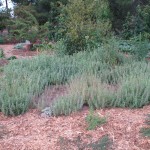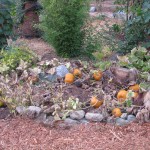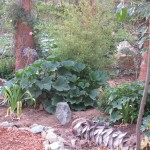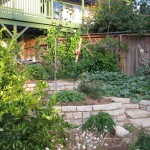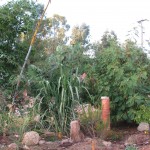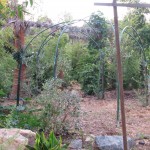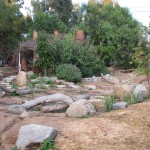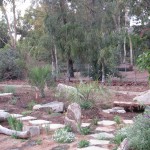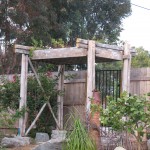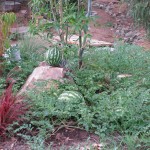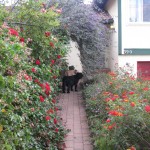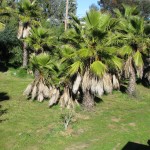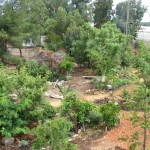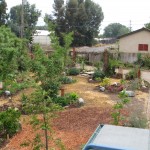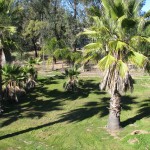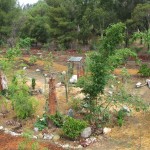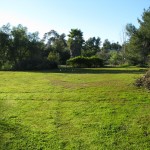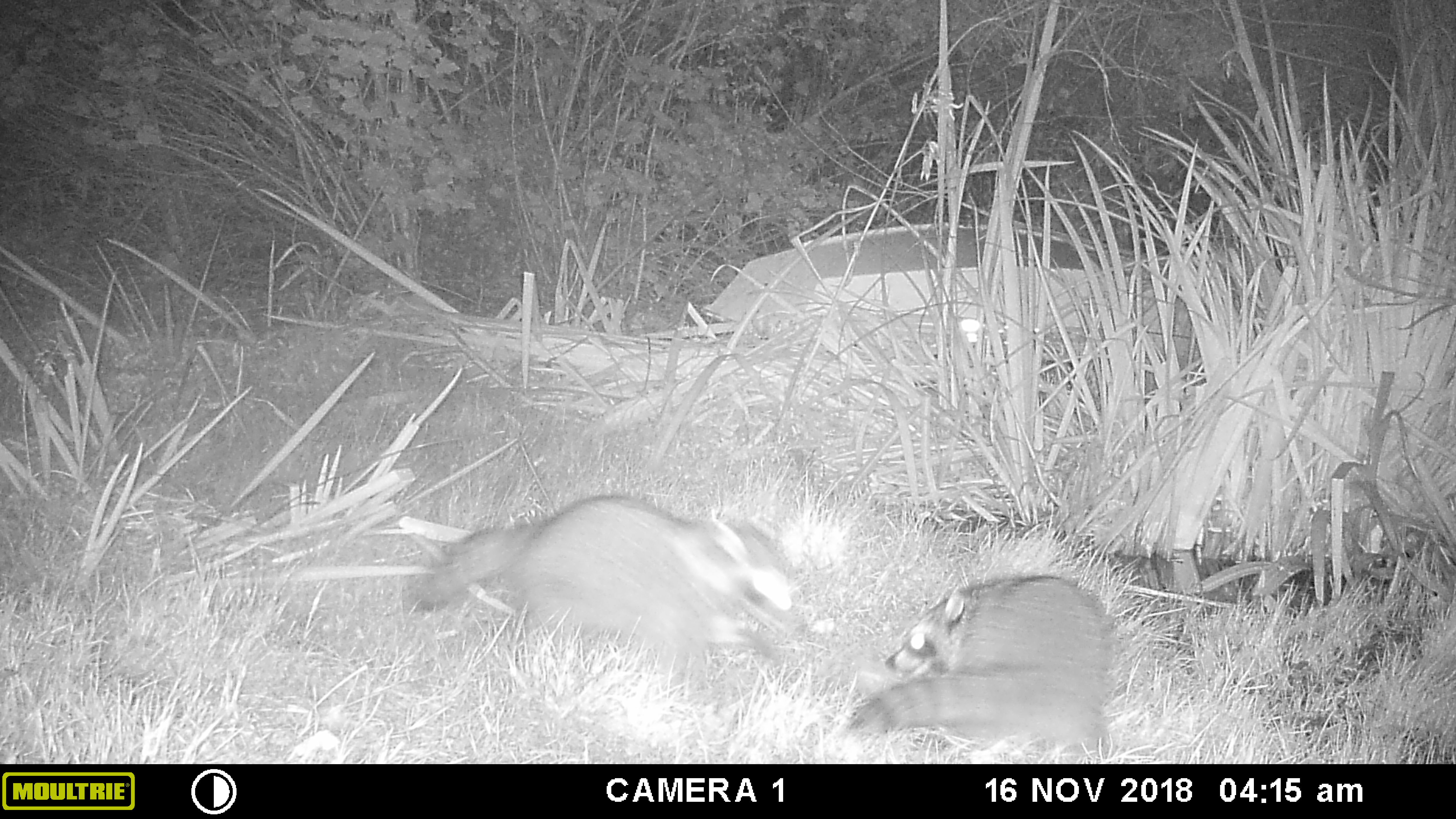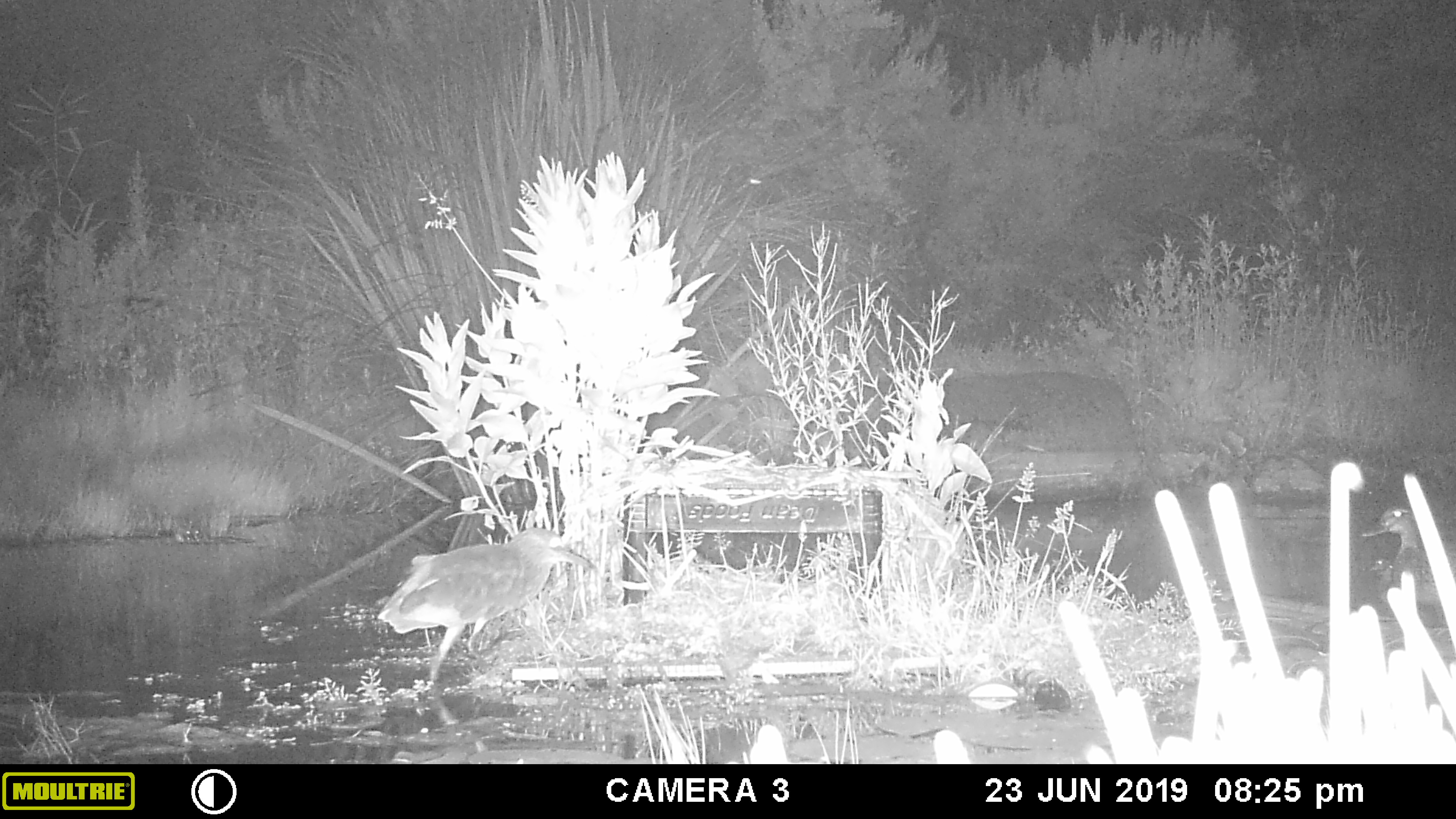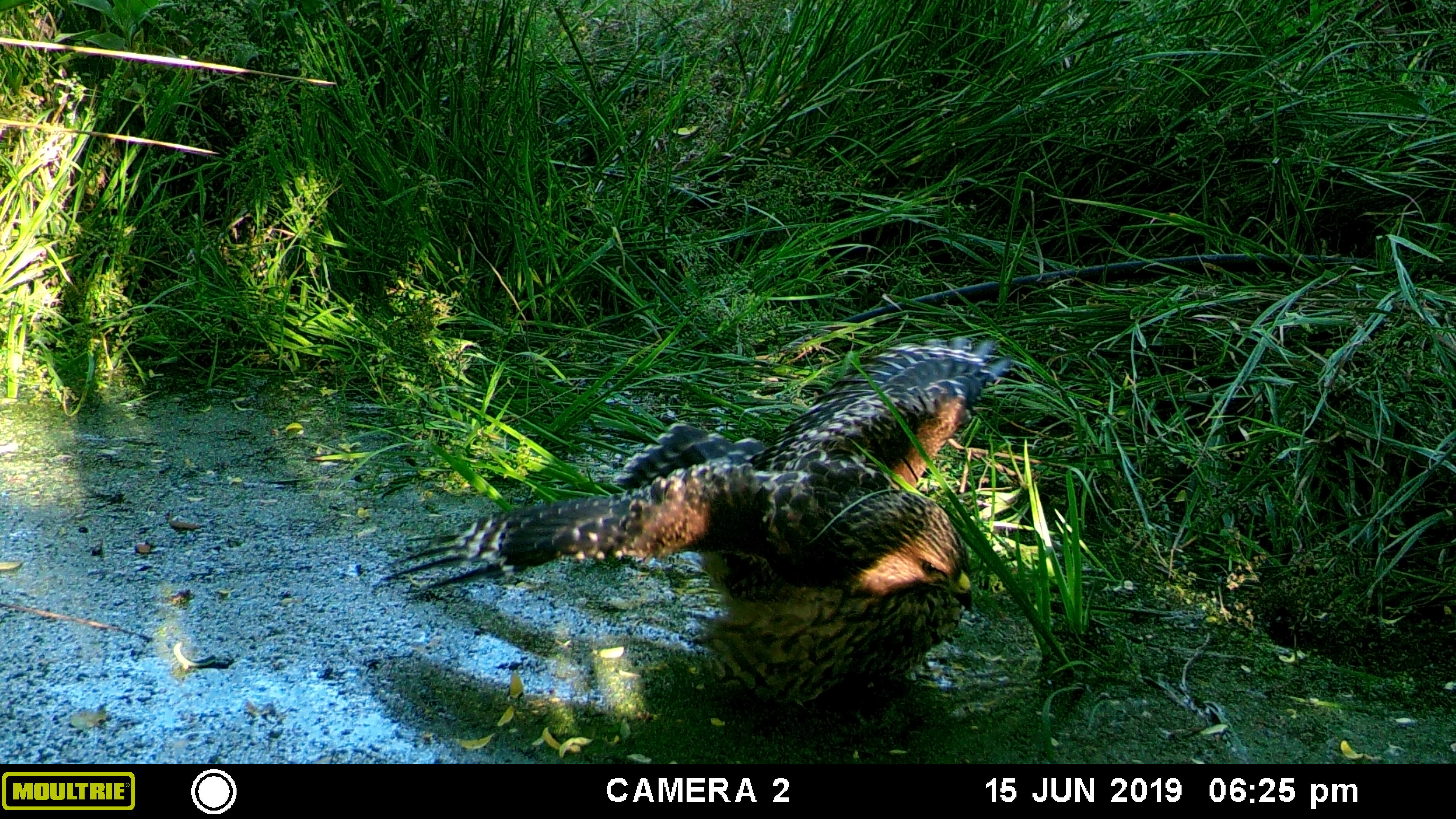- Bees, Gardening adventures, Other Insects, Permaculture and Edible Forest Gardening Adventures, Vegetables
Nitrogen-Fixing Plants
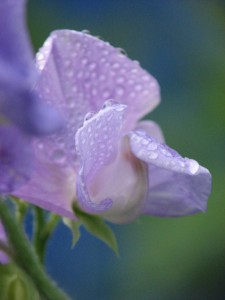
Sweet pea If you’ve read my posts from this spring, you’ll have endured me going on and on about peas and beans and how they fix nitrogen in the soil. For those who nodded off during those episodes or who have just tuned in, I’ll go over it briefly.
Some plants have the ability to fix nitrogen in the soil. Actually, a type of bacteria called a rhizobia invades the roots of plants in the Fabacea family and a few others, and fixes atmospheric nitrogen in nodules on the plant’s roots. This is beneficial to both the plant and the bacteria, a process called mutulism. It also benefits whatever grows around the plants because, when the plant dies, the nodules release their nitrogen into the surrounding soil. In the case of long-lived shrubs and trees that fix nitrogen, as roots die off or are replaced, they release their nitrogen.
An edible forest garden is one where man mimicks the dynamics of an old-growth forest. Why? Because forests succeed without the aid of fertilizer, tilling, mulching, irrigation or any interference or ‘help’, as it were, from man. How does it do this? The plants that grow complement each other, providing what each other needs. These relationships are called plant guilds. You can create plant guilds, substituting plants that provide food for humans. In a guild there is a taller tree which provides shade and leaf droppings (mulch), shrubs which provide more shade, mulch and habitat for animals and insects, plants that fix nitrogen in the soil, plants that have long tap roots called ‘miner’ plants, because they take up nutrients from deep in the soil and deposit them on the soil surface when their leaves die off, plants that attract pollinators, and plants that are ground covers to regulate heat and moisture. Using permaculture practices for water harvesting and organic gardening, when the guild matures it should be almost completely self-sustaining.
Say you want to plant an apple tree. That would be your tall canopy tree for the guild, which drops leaves as mulch. Beneath it, you could plant a shrubby herb such as rosemary (another edible), daikon radishes (miners, leaving the cut leaves on the surface after harvesting the edible root), bush beans (legumes) and herbs such as dill, parsley and basil, some of which you allow to flower for pollinators. As the tree grows, the plant guild can widen and others planted.
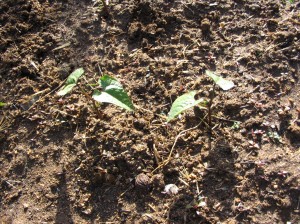
Beans There are many plants, trees and shrubs that fix nitrogen in the soil. All beans and peas including soybeans and fava beans do; when the plants are finished cut them above the soil so the roots stay put and decay where they are to release the nitrogen. Cover crops such as clover and hairy vetch are grown and turned under to improve the nitrogen in the soil. If you are from the Southern California area, perhaps you’d be interested in knowing what native plants are nitrogen fixers.

Ceanothus (California Lilac) at Elfin Forest The native Southern California nitrogen fixers include: ceanothus, lupine, deerweed, California peashrub (endangered) (lotus), and redbud. Non-natives that are commonly used are alders, acacias, calliandra, sweet peas, guaja, and many more, as the Fabacea family is very large. Use any of the natives in ornamental gardens and not only will you be improving the soil and the vigor of the surrounding plants, but providing much needed habitat for our native birds and insects.
Try building plant guilds; it is challenging and fun. Many combinations of plants are suggested on permaculture
- Gardening adventures, Permaculture and Edible Forest Gardening Adventures, Photos, Ponds, Rain Catching
The October Garden
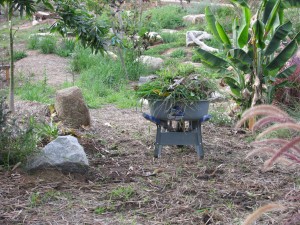
Weeding The weeds took advantage of the warm weather and my absence last week to really get some growing in. I’m pulling each weed by hand, shaking off the dirt (trying not to get showered with it in my eye), and composting them. The greens when layered with brown material (dead clippings, etc.) will cook nicely for use next year. I have a tall wire cage set up in one of the raised beds I haven’t filled yet, so the compost will be made right where it will be used.
Meanwhile the garden grows. Melon vines are dying, but the squash continues on!

Luffa vines grew up the palm trunks, then down again to the ground! With permaculture the idea is to mimic a forest dynamic, with lots of plants helping each other grow by providing elements other plants lack, such as nitrogen, mulch, shade, flowers to attract pollinators, etc. You can fit a lot of plants into a small area.
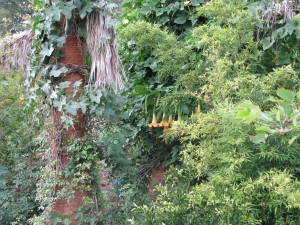
You can fit a lot of plants in a small space with adequate nutrients and water 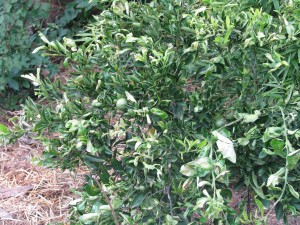
Trouble with citrus The orange tree above is receiving too much irrigation water due to its placement on sloping land and the nearness of water-loving plants. Planning beds with compatible plants providing adequate initial nutrition and water can result in happy masses of plants.

The palm walkway has become a jungle tunnel 
Bamboo and sugarcane 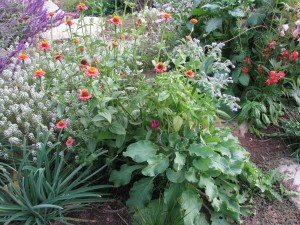
Bee and butterfly seed mix The pond, now six months old, looks as if it has been on the property for years.

The pond looking natural The melon vines and pumpkins have not only protected the land from the scorching summer sun, but will provide good compost and certainly are decorative as well as sources of food. I always wanted to wait for the Great Pumpkin!
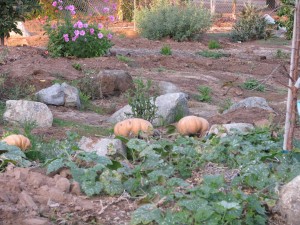
Cinderella pumpkins, with purple cosmos across the dry streambed Sages, mints and butterfly bushes continue to flower, providing much needed pollen sources for bees in this season of dearth.
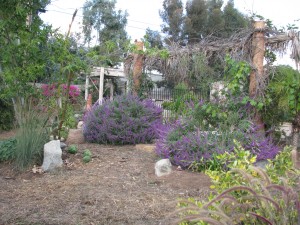
The entranceway 
Bananas and sage Meanwhile in the vegetable garden many crops have had their day and I’m composting them as I get to them. Some such as the eggplant are still going strong. (See my steamed eggplant recipe! Yum!) .

Another giant eggplant hiding in the strawberries A garden as large as this can be overwhelming, especially in its first year. I’m trying to think in sections. I enjoy working the garden, making it mine and seeing the surprises that show up. My back and hands aren’t as happy, especially the morning after, but… too bad! “Get over it, guys!” I say, then realize I’m talking to my body parts. Alone in my garden, only the plants really care, and they aren’t looking. Or are they?
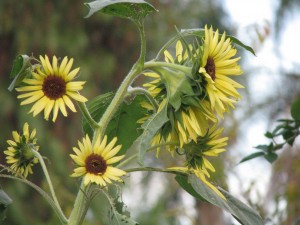
Sunflower keeping an eye out in all directions -
Heavenly Steamed Eggplant
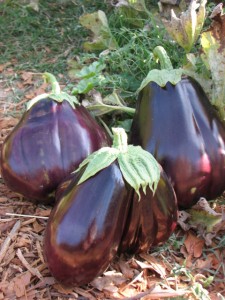
Black Beauty eggplant I love eggplant, but always thought it had to be salted, pressed and fried or baked. Cookbooks always talk about bitter juices that need to be leeched out. The recipe for Coucharas (see recipe list) calls for steaming eggplant until it is very soft so that the pulp can be mashed and combined with other ingredients.
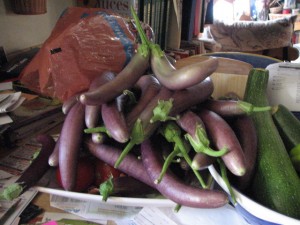
Japanese or Chinese (long) eggplants have few seeds Now with an abundance of eggplant, both Black Beauty and Japanese, in my garden, I looked for some simple eggplant recipes. Maybe everyone else in the world knows how incredible lightly steamed eggplant is, but I just found out!
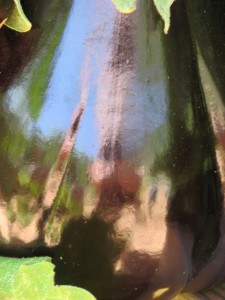
Choose glossy, firm eggplants I took a Black Beauty (globe) eggplant that I’d harvested the week before and was beginning to go soft, cut off the stem end and quartered it lengthwise. I steamed the slices for 8 minutes (no more than 10!).
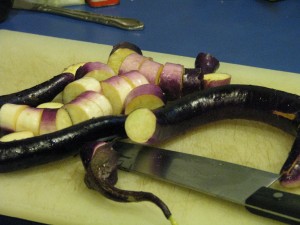
Slice long eggplants into bite-sized chunks The texture was silky and smooth, not at all bitter and incredibly light. Over the top of the quarters I spooned a very easy sauce. The eggplant, which is notoriously spongy, soaked up the sauce. Slicing the eggplant, skin and all, was a dream and eating it was sublime.
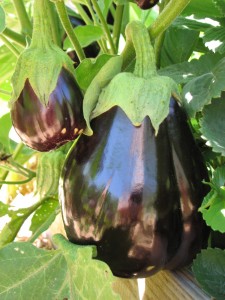
Eggplant is in the same family as tomatoes and potatoes It was so good in fact that I did the same with Japanese eggplant the next night, but instead of quartering them, I cut them into bite-sized chunks, then after steaming poured the sauce over them in a bowl and stirred them around to absorb the sauce. I served both with very thin noodles. Photos of cooked eggplant are rarely delicious-looking, so you’ll have to let your imagination guide you.
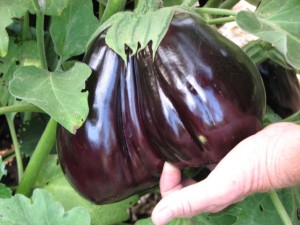
An enormous double eggplant! There are many sauce mixtures on the Internet, but here is mine:
Heavenly Steamed EggplantAuthor: Diane KennedyRecipe type: Main DishPrep time:Cook time:Total time:Serves: 2-4Quick, light, tasty, low-calorie and wonderfully different, this eggplant recipe is a gem.Ingredients- One large Black Beauty eggplant or 3 Japanese eggplants
- 2 Tablespoons Rice Wine Vinegar (or other mild vinegar)
- ⅛th cup Bragg's Amino Acids, Tamari Sauce or low-salt soy sauce
- ¼ teaspoon sesame oil
- 2 Tablespoons olive oil
- ½ teaspoon grated fresh ginger
- If you like garlic, dice or grate a small clove and add it in. You can also include chili paste to taste.
- Fresh cilantro (optional)
- Toasted sesame seeds (optonal)
Instructions- Cut stem end(s) off the eggplant
- If using one large eggplant, cut it into quarters long-wise from end-to-end. If using long eggplant, cut into ¾" - 1" bite-sized chunks. Do not peel.
- Steam eggplant for 8-10 minutes until a knife easily slides into the skin; do not overcook!
- Meanwhile, mix all sauce ingredients except cilantro or sesame seeds, if using.
- Plate the eggplant quarters and drizzle the sauce over the top slowly so it absorbs, or put chunks in bowl and mix with sauce, then plate. Offer extra sauce separately.
- Sprinkle with fresh, chopped cilantro and/or toasted sesame seeds.
- Very good with noodles or rice.
- Bees, Birding, Gardening adventures, Heirloom Plants, Other Insects, Permaculture and Edible Forest Gardening Adventures, Photos
Bouquets for Birds and Butterflies

Lilliput zinnia At the beginning of this summer, the new subterranean drip irrigation system was installed on my property. It features tubing with holes at either twelve or twenty-four inches apart. When it runs (from my well) it leaves circles of dampness polka-dotting the soil surface. I had purchased two packets of wildflower seed, one with a selection of plants to attract bees, and the other for butterflies. Mixing them together, I figured that they wouldn’t fare well scattered, at least this year. My daughter and I pressed seed into many of the wet spots and hoped the rabbits wouldn’t notice.
What happened was a delightful surprise, as only a garden can provide. In many locations around the yard grew mixed bouquets of wildflowers.

Mexican sunflower, cosmos, nasturtiums, zinnias, surround a white calla lily If we had separated selected seed and planned the planting, nothing so beautiful would have come of it. Although many species either didn’t emerge or were eaten, the most common survivors were zinnias, cosmos and borage.

Cosmos, borage, zinnias and alyssum. I was amazed and thrilled; I had purchased a borage plant and then fed it to the rabbits (at least, that is what they thought). Here now are borage plants all over the yard, their royal blue, cucumber-flavored flowers dipping modestly behind the flaunting cosmos.
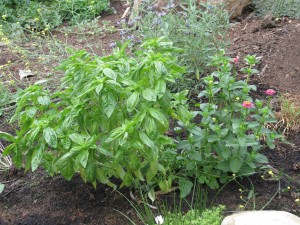
Sweet basil, cilantro, dill and zinnias In fact, I now have several very hearty sweet basil plants that put the carefully cultivated plants in my raised veggie beds to shame. There is also dill and cilantro growing well even this late in the season.

Cosmos, sweet basil, zinnias, borage, camellia balsam, alyssum There are some plants in the bouquets that haven’t reached maturity yet, so there may still be some surprises. The only flower that emerged that I didn’t recognize and had to look up was camellia balsam (Impatiens balsamina). Two stalks of it, one pink and one red, give these ‘arrangements’ a vertical line.
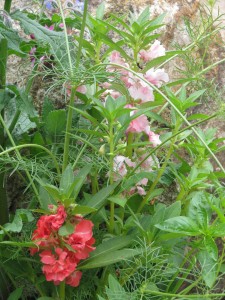
Camellia balsam (Impatiens balsamina) Although not all of these wildflowers are native to San Diego, or even California, they provide food for birds, bees and are host plants for butterflies, providing the caterpillars food, a place to form their chrysalises, and nectar for the mature butterfly. Bees like small flowers with little drops of nectar too small to drown in, with a nice landing pad of a petal close by. Everything in the carrot family works well. Here are some suggested flowers to plant:
For butterflies:
Mexican lupine, Mexican sunflower, borage, calendula, camellia balsam, scabiosa, cornflower, milkweed, parsley, crimson clover, aster, coreopsis, cosmos, prairie gayfeather, purple coneflower, sweet sultan, sneezeweed, sweet William, bishops flower, black-eyed Susan, dill, snapdragon, yarrow, bergamot, cleome, verbena, and butterfly bush.
For bees:
Cosmos, sunflowers, borage, coriander, Siberian wallflower, dill, coreopsis, poppies, gaillardia, zinnia, sweet basil, purple prairie clover, globe gillia, catnip, lemon mint, black-eyed Susan, goldenrod, lavender hyssop, bergamot, yarrow, mint, California buckwheat.
Be sure to plant flowers that bees love away from paths and walkways if you or your family want to avoid contact with the bees.
-
First Rain
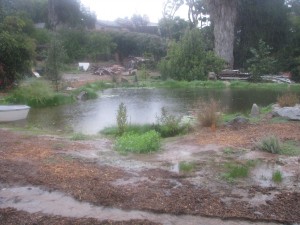
Rainfall on the pond The first week of October and we’re having a day of heavy rain… almost unbelievable. Normally October in San Diego is high fire season. The brush is crisp from months of drought and high temperatures, and then the Santa Ana winds begin: wild dry winds that blow east to west from the deserts, full of static and mad gusts that turn brush fires into firestorms.
My property is a watershed, funneling rainwater from the street through to the streambed in the barranca below, taking all my topsoil and some of the embankment with it. This year I had the beginnings of a permaculture garden installed to remedy this pattern. By deepening the loam and placing berms around plant guilds water is encouraged to pool up and soak in rather than run off. Overflow is channeled through a series of dry ponds which allow water to soak into the ground. From there it is channeled safely down to an overflow into the stream. Today was an early test of what has been worked on since Feb. 1.
The tilling, mulching and berming done by the crew of landscape architect Roger Boddaert proved successful.
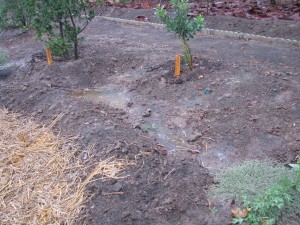
Berms hold water back so that it may soak into the loam The soil has a high clay content, which was good news when digging the large pond because it held water without a liner. It is bad news for other areas of the garden where water is pooling up instead of sinking in. I was able to take note of these areas this afternoon so that they could be drained and mulched for more absorption.
Aquascape, the company that installed the series of ponds, is still planting and maintaining the waterways. Jacob came out in the rain and watched it flow, shaping and fortifying as the force of the rain and thus the volume increased.
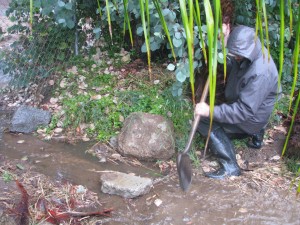
Jacob helping water flow Water flowed under the fence from the street, but instead of flooding a cement culvert as it used to do, it is channeled down to the ponds.
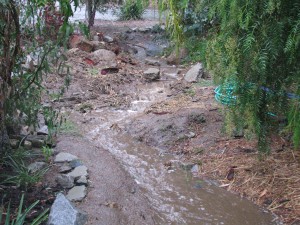
Street run-off enters under the fence 
Blocked by debris, water floods past the bridge Silt and debris blocked water flow under the bridge, and was eroding the area by the structure called the Nest. I cleared the debris and raked rocks and silt to the weak side, and that fixed the problem temporarily.
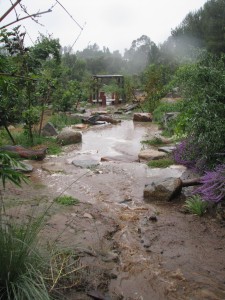
Rainwater flowing into the first 'dry' pond Water quickly filled the first dry pond; with the high clay content, water percolates but does it slowly.
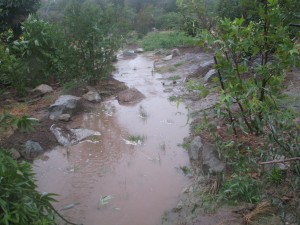
'Dry' ponds filling and slowing run-off 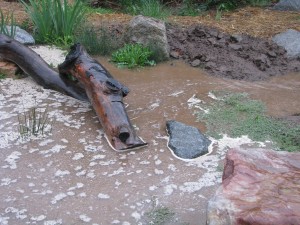
Logs and rocks are ornamental and slow water flow 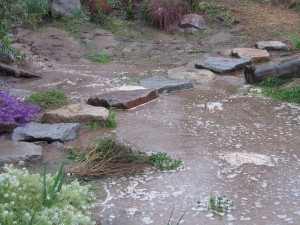
Normally dry, the stone crossing is now almost underwater 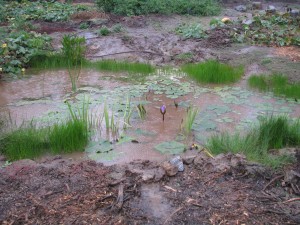
The little pond is rapidly filled. As water reached the small pond, which wasn’t intended to permanently hold water but the clay had a different idea, the sides had to be shored up and the overflow diverted.
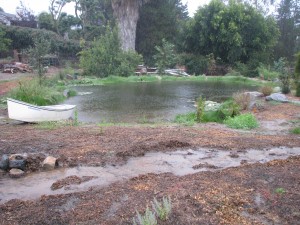
Water is diverted from the little pond around the big one Extra floodwaters aren’t being diverted into the large pond because we don’t want it filled with silt, and we don’t want it overflowing rapidly and eroding the sides. Instead the water flows through a channel around the large pond, then down to a prescribed place to flow out and over the embankment to the stream below.
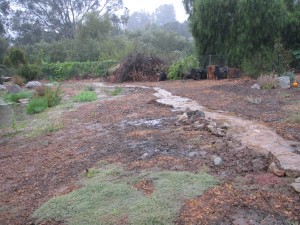
Overflow is channelled past the ponds and out to the natural stream below Some areas of heavy erosion had been filled and supported, and as of six this evening they looked wet but not iffy. What a night of heavy rain will do, I’ll have to see in the morning. I am very lucky to have this type of
rain early in the season. It has been heavy enough to cause significant water flow to help shape the watercourse and show weak spots, and the rain will be reduced to showers tomorrow then clear up, so repairs and improvements can be made before true flooding happens later in the year or early in the next.Although much more water is being held on the property, and topsoil is not being lost, it still pains me to see so much rain channeled out to the stream. Rainwater is a neutral Ph, and carries nitrogen (especially when
there is lightning). It is the best possible water for plants, as well as for human consumption and bathing. In side-by-side comparisons with tap water, plants watered with rainwater flourish far beyond the growth of the others. I’m greedy to hold that water onto my property, letting it soak as deeply as possible for tree roots to use far into the year. As the newly planted trees grow, their roots will help hold water and soil. As their leaves drop the mulch levels will raise, aided by compost and mulch that I will be constantly adding, and the soil will become more absorbent farther down. Each rain should have less runoff and more absorption. This rain has shown a great success with the garden, but I know it is only the beginning. -
King Watermelon
This year I grew watermelons. I planted organic seed in my raised vegetable bed, protected from gophers by aviary wire, grown in excellent soil and fertilized with organic fertilizer, watered often, and the vines produced three melons the size of grapefruit. The chickens enjoyed them very much. However, a non-organic watermelon from a six-pack stuck in the ground under a bamboo, decided to take over the world. Not only did it’s foliage cover a good portion of the upper soil, but it grew and has grown enormous beasts of watermelons. One we call King Watermelon.

King Watermelon is in the foreground, laying in wait. My daughter and I watched a YouTube video on how to tell if a melon is ripe. One way is to watch the tendril opposite the stem of the watermelon, and when it turns brown the melon should be ripe. The area where the stem connects to the fruit should also turn a little brown. Also, under the melon should be a pale spot where it rests on the ground, and when that area turns from white to yellowish, that is another sign. King Watermelon had no spot. We checked every few days for weeks as the beast grew larger and larger, it’d tendril tenaciously green. Then suddenly, it was brown. Much celebration. My petite collegiate daughter crept up on King Watermelon and swiftly cut it’s stem. Then staggering with it, brought it into the house where we weighed it. It was an incredible 28 pounds. It is a wonder that any other plant in the area got any irrigation! Normally we’d slice the melon on the countertop, but King Watermelon was so large that he had to go into the kitchen sink, and he barely fit! It was there that he was butchered, in consideration of all the juice that might come out.

So large it had to be 'butchered' in the kitchen sink! The insides were perfectly sweet, juicy and crunchy. I couldn’t believe how perfect it was.

Beautiful inside; sweet and crisp. My daughter cut and cut, saving some for our dinner (all that extra water before bedtime wasn’t a great idea, though), and wrapping the rest. The chunks had to be stored on cookie sheets to distribute the weight on the shelves and protect from leaking juice. We had watermelon the next day too, and fed some to our very grateful and thirsty tortoise during the heat wave. There is a lot of King Watermelon left. It is scary to look into the refrigerator and see it all. Even cut up and wrapped, that melon still has an attitude. And I think he won the battle after all.

Wrapped sections for infinite eating. And there are more melons ripening with each passing minute. Gulp.
-
Finches Eat Sunflower Leaves
Are your sunflowers being stripped? Are the leaves acquiring non-snail-like holes and then disappearing altogether? You may be feeding the birds, but not with the seeds!
Lesser goldfinches apparently are nuts over sunflower leaves. They will tear little bits of the leaves off and injest them, and within a day or so there will be nothing but a stem and a flower.

If your goal is to feed the birds, then this is okay. If you have bird problems on your vegetables such as peppers, then you may want to plant sunflowers off to the side to distract them.

Why do they eat sunflower leaves? They must like a little salad with their seeds, and sunflowers are particularly yummy for them. In searching the Internet for suggestions as to why they like sunflower leaves so much, there were many postings about the incidents, and yet most respondents insisted that the birds were after bugs on the leaves, or that snails came in the night and ate the leaves!
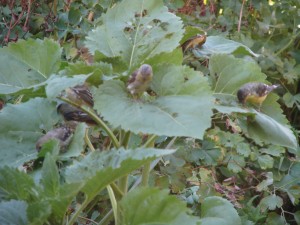
This occurrence seems to happen mostly in California, and other than bird nets (which one person said that the lesser goldfinches chewed through!) or planting sunflowers thickly (one for them, one for you), you may as well just enjoy the show. Ours come up from dropped or buried birdseed, and when the plants are growing their flowers, suddenly they are beset by birds who skeletonize the plant. We’re okay with that; it saves a little cost on the very expensive Niger thistle seed! (Oh, and by the way, Niger thistle isn’t thistle seed at all).
- Chickens, Gardening adventures, Heirloom Plants, Permaculture and Edible Forest Gardening Adventures, Photos, Ponds, Rain Catching, Vegetables, Vegetarian
The August Garden
Plants have been enjoying the beautiful weather and the constant irrigation from the well, and the garden is flourishing. So, unfortunately, is the Bermuda grass, but that is another tale. Since I see it everyday I don’t notice the change so much, but when I show someone around I am thrilled all over again with the incredible change that has happened on this property. There are so many birds, insects, reptiles and other animals either already here or scouting it out that I know the project is a success. It is a habitat, not just for me and my family, but for native flora and fauna as well. It wasn’t so long ago that I had a cracked, weedy asphalt driveway, a termite-ridden rickety porch that needed pest control, a house with a stinky deteriorating carpet and old splotchy paint, a tile kitchen counter with the grout gone in between and a cleaning nightmare, and a yard full of snails, weeds and Washingtonia palm trees, with the embankment eroding each rainfall. Over the last four years we’ve survived some pretty intense construction projects (none of which were done on time, no matter what they promised!). My house still has some repairs that need to be done but I no longer am embarrassed to have anyone over. The garden is wonderful to walk in and explore. I’ve taken some photos this evening to show you how things are growing:
Bees enjoying purple coneflowers The luffa squash has mighty asperations. A luffa squash and bloom. They are edible small and green, but I’ll leave them to dry. Five eggs today! Each laying hen participated for the first time! The little girls have grown up. The small lower pond and the palm pathway. The veggie bed. Rushes, fleabane, waterlilies and other plants are growing in nicely around the big pond. The boat is still on loan from Aquascape. A pumpkin tree? This apricot isn’t healthy, but the pumpkins sure are. These bare areas I’ll fill with plants that will make up guilds, each plant filling a niche to help the others grow. The entrance to the bee garden. Native vinegar weed loves a place we left untouched, and so do the bees. Sugar pumpkins ready a little early for Halloween. A feral zucchini, still producing at least one a day. Melons, passionfruit, pitcher plant and many others under the back porch we call the Poop Deck. Very eager bamboo, sugarcane and hops. Olive trees tied to painted PVC pipe to make a hut. The ‘Nest’ beyond the dry stream bed. A thud and a swish… with no warning the neighbor’s tree fell across the fence. A green roof for the entranceway, just beginning to show. The watermelons in the vegetable beds were tiny… these monsters are wild. That one grew on the rock on its own. Entranceway flower tunnel… with dogs waiting to go inside! -
Stinkhorn!

What is that? There was a surprise in our garden this afternoon. We were weeding and planting a flower seed mixture around the back of the house, and suddenly my daughter excitedly shouted, “Stinkhorn!” I didn’t take offence. I was excited, too. What she was referring to was a reddish, odd-looking fungus that had emerged from the ground next to a rose bush. This fungus makes a rather unpleasant odor, which attracts flies who then carry off the spores. A pretty tricky plant. We had our first and only stinkhorn emerge last year in a different part of our yard, and I was afraid that with all the walking and weeding done in that area, that it wouldn’t be back. Silly me. The fungus was traveling!

Flies enjoying the stink and spreading the spores Then shortly after this discovery and only a few feet from it, I was digging up weeds and found what I thought was a reptile egg. We thought that maybe it was an egg from Mrs. Sabatini, the Western pond turtle that we found on our property and released into our upper pond, never to be seen again. Or perhaps a snake egg.
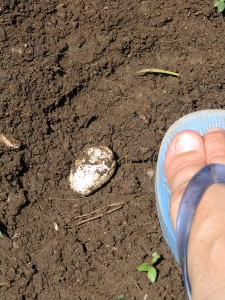
Not a reptile egg When I felt it, however, it was firm and had a little give to it, like it was made of soft rubber. My daughter figured it out. She had read where the stinkhorn spores grow into an egg-shaped, um, thingy, which breaks open underground revealing the slimy gooey part which then pushes up through the ground and begins stinking. The slimy part has the spores on it.

The shiny green interior will thrust out of the ground Fungus is incredible and wonderful. The threads of fungus hold together the soil, feed us, medicate us and yet we know so little about them. An incredible book to read is Mycelium Running: how mushrooms can help save the world, by Paul Stamets. Although most people wouldn’t welcome a stinkhorn into their perennial border, we think it is very cool, as long as there aren’t too many of them!
-
Midsummer Garden
When I’m in the garden everyday, I find that I forget that only seven months ago, things looked radically different. I’ll post some before and now photos below:
View to pond, before View to veg now Out to neighbors before View to neighbors now Entryway before Entryway now Middle property before Middle property now Lower yard before Lower yard now What a difference six months can make!
